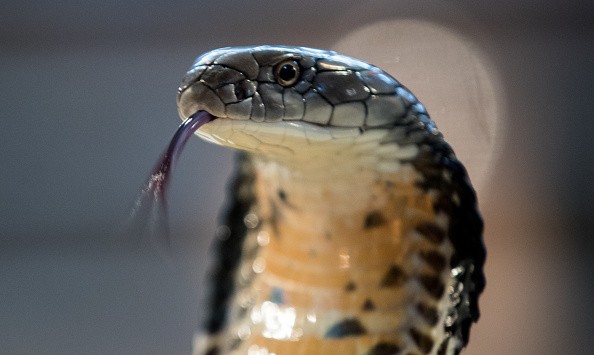Herpetologists have long been puzzled about how the king cobra, which slithers across vast Asian landscapes split by seemingly impenetrable divides like the Himalayas, could be a single species.
They were also perplexed by the fact that the world's longest venomous snake, which can reach a length of 18 feet, has a variety of appearances and behaviors depending on where it lives.

A recent study shows that the king cobra is actually a "royal family" comprising four distinct species.
Royal Family
In August, P. Gowri Shankar, a biologist and king cobra expert at the Kalinga Foundation, a conservation NGO in Shivamogga, India, and his colleagues published a study that identified four genetically distinct kingdoms cobra lineages.
They classified them as Western Ghats (southwestern India), Indo-Chinese (eastern India and China), Indo-Malayan (Indonesia and Malaysia), and Luzon Island (Indonesia and Malaysia) (Philippines). The International Commission on Zoological Nomenclature has yet to approve the snakes' scientific names.
Catching Snakes for Years
Years of daring snake catching in tropical rainforests, combined with modern technology that can examine highly degraded museum specimens, generated enough DNA for scientists to identify the additional species correctly.
A king cobra can rear up to eye level and deliver enough venom to kill an elephant if it is disturbed. Shankar claims to be one of the few persons who has survived a king cobra bite, owing to the minimal amount of venom injected by the snake.
Indeed, the fact that cobras are different enough to be classified as four other species could have important implications in the real world, he says, particularly in developing a more efficient antivenom that can target the various venoms of these species.
Furthermore, the discovery of the new species could aid conservation efforts for snakes, which are falling across their range due to deforestation and urbanization, according to Shankar. The king cobra is vulnerable to extinction by the International Union for Conservation of Nature (IUCN).
Understanding Misunderstood Reptiles
According to Philip Bowles, coordinator of the IUCN's Snake and Lizard Red List Authority, which surveys reptiles in the wild worldwide and evaluates their conservation status, the king cobra's conservation status will be reassessed in light of the findings.
Romulus Whitaker, a longtime snake specialist and creator of India's Chennai Snake Park, a nonprofit that educates the public about snakes, says that after looking at [king cobras] intently for more than 50 years, you can see that "they are... different."
Scientists have pondered why adult king cobras in Thailarelatnd and adjacent countries have more than 70 off-white bands encircling their bodies, but those in the Philippines only have a few that are hardly recognizable.
Nesting habits vary as well. The only snake that makes nests for its eggs is the female king cobra, which is no minor task for a limbless creature. She shimmies, twigs and leaves into position with her body. (Enter the largest snake gathering in the world.)
Increasing Awareness
Shankar hopes that increased awareness of king cobras would lead to a shift in public opinion.
Many Hindus in rural India revere the king cobra and regard its presence in their fields as a sign of good fortune. However, the snake is reviled in other parts of the world, leading to indiscriminate deaths.
When a person comes face to face with a king cobra, its intimidating size and dog-like "growl" are more than enough to prevent any conflict.
The most frequent bite victims are hunters pursuing the animals for their skin and body parts for use in traditional medicine, but wildlife rescuers removing king cobras from people's houses are also at risk.
Instead of posing a severe threat to humans, king cobras assist us by preying on other snakes, even their kind. Venomous snakes such as pit vipers, whose bites kill up to 140,000 people worldwide each year, are among their prey.
A generic antivenom made by the Thai Red Cross Society is frequently given to those bitten by a king cobra; however, it isn't always effective against king cobra bites in different sections of the snake's habitat.
Putting the Discovery to Use
According to Kartik Sunagar, a snake venom expert and associate professor at the Indian Institute of Science in Bengaluru, the immediate utility of this discovery may be limited because the chemical composition of venom can vary even within species. Because king cobra bites are uncommon, there isn't much incentive for a corporation to manufacture relevant items.
National Geographic reached out to several antivenom makers in India, including the Haffkine Institute, for feedback on the possibility of developing a new king cobra antivenom.
However, Sunagar believes that a better understanding of the snake could aid in creating more focused antivenoms in the short term and more effective medicine against all king cobra bites in the long run.
According to conservationists, some king cobras, especially those on Luzon Island, are facing extinction. Their population is unknown, but Shankar believes it is small and vulnerable to significant natural disasters like earthquakes and tsunamis, common in the region.
Meanwhile, Shankar and his colleagues are still looking for more king cobra species, believing that at least one more exists in Indonesia.
For more animal news, don't forget to follow Nature World News!
© 2025 NatureWorldNews.com All rights reserved. Do not reproduce without permission.





